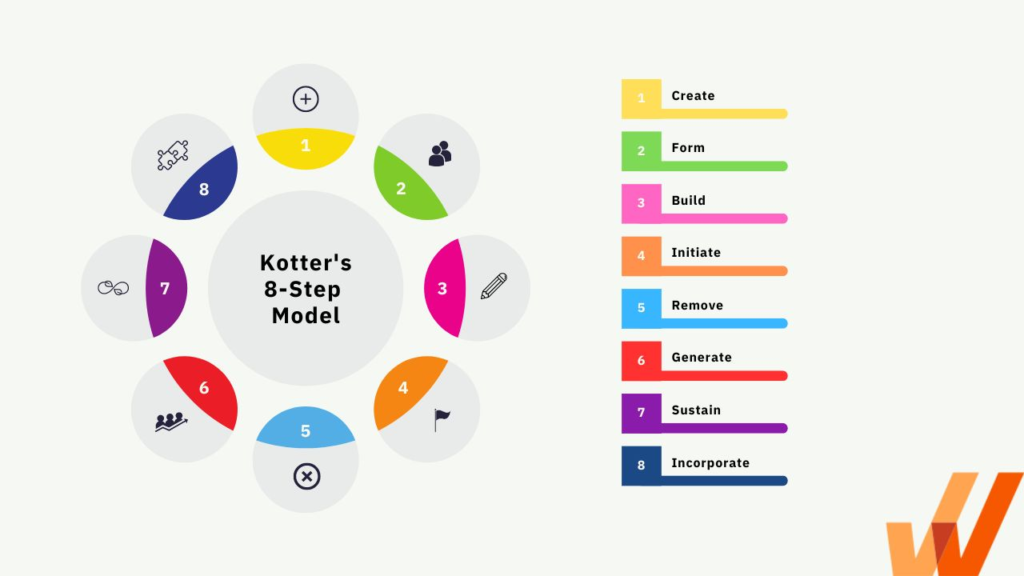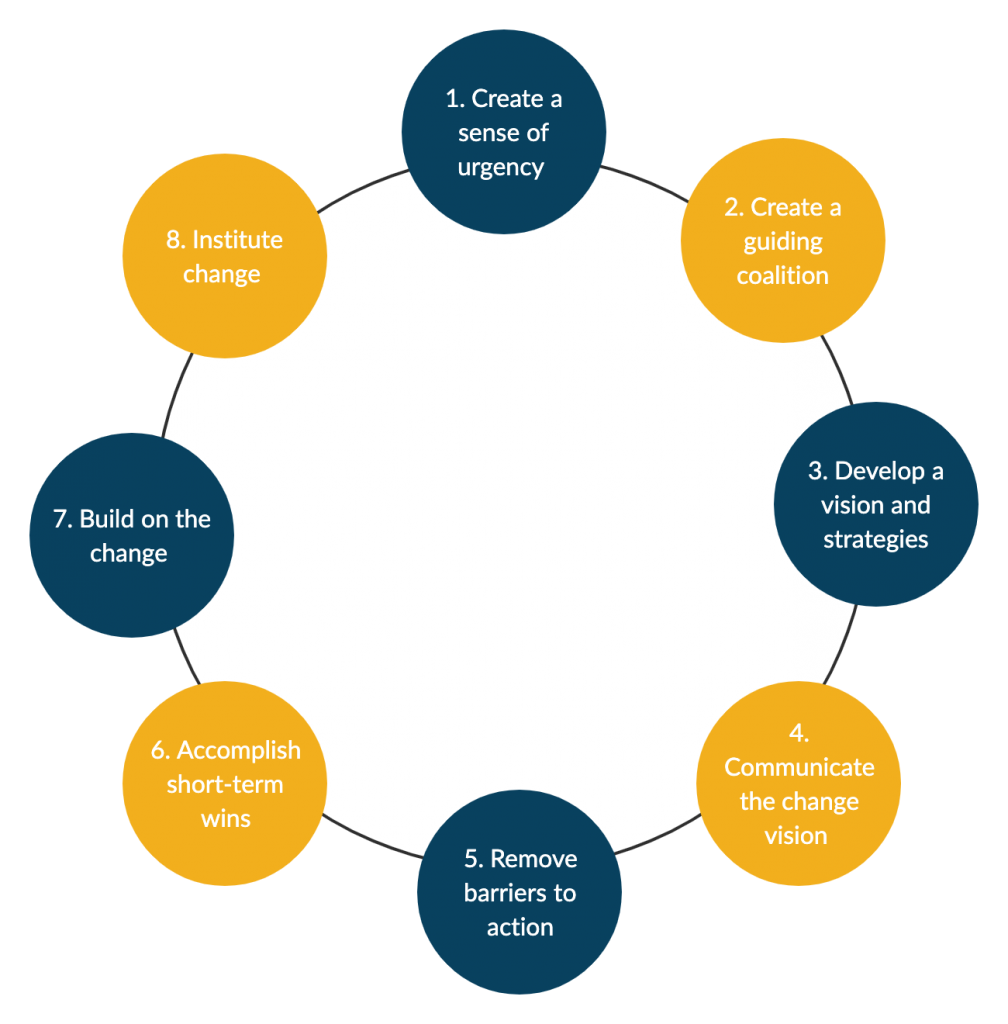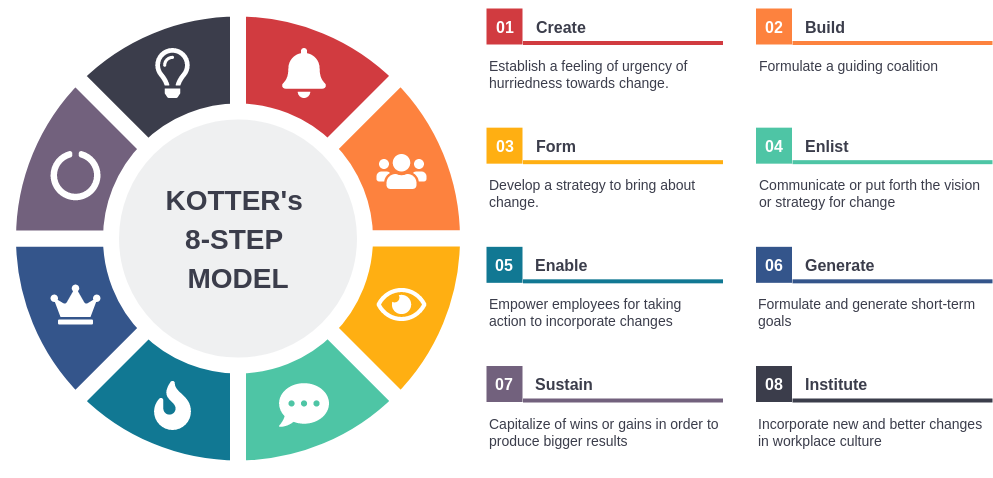Organizational change is an inevitable challenge businesses face in the ever-evolving market landscape. Leaders and managers often grapple with the problem of implementing change effectively—be it through mergers, acquisitions, restructuring, or cultural shifts within their organizations.
While change can mean progress and growth, it can also lead to resistance, fear, and inefficiency if not managed correctly.
The solution to this pervasive issue is leveraging proven models like Kotter’s 8 step training model.
This model, developed by Harvard professor Dr. John P. Kotter, provides a clear roadmap for driving successful change. Its step-by-step approach aims to preempt pitfalls and inspire buy-in at all levels of the organization.
By dissecting each step’s advantages and potential drawbacks, this guide will offer valuable insights into navigating complex change with confidence and strategic finesse.
What Is Kotter’s 8 Step Training Model?
Kotter’s 8 step training model is a methodology designed to help organizations implement effective change. Simply put, this model serves as a checklist of eight critical stages that guide teams from conception to implementation of change. Here’s a quick rundown:
- Create Urgency: For change to happen, it typically requires a catalyst or a compelling reason. Creating a sense of urgency among employees helps motivate and jump-start the initial move. For example, a tech company might highlight the need to innovate rapidly due to increased competition and the risk of becoming obsolete.
- Form a Powerful Coalition: Change is not a solo sport. It demands a team effort. Gather a group of influential, driven and committed individuals in your company. Think of a startup where a small team of leaders and early adopters champion the change initiative.
- Create a Vision for Change: When you can articulate a clear vision, your chances of success skyrocket. This vision simplifies complex change into an understandable and desirable goal. Imagine a retail company envisioning a shift to complete online sales, painting a picture of wider reach and convenience for customers.
- Communicate the Vision: The vision must be communicated effectively and frequently. Leaders should discuss the change vision every chance they get and embed it in everything from training sessions to company emails. A notable example is the CEO of an automaker regularly discussing his vision for sustainable transportation in interviews and social media.
- Remove Obstacles: Any barrier to change should be removed, including changing structures, revising policies, or getting skeptical buy-in. For instance, a major bank might streamline its approval processes to facilitate faster innovation.
- Create Short-term Wins: Nothing motivates more than success. Plan for short-term victories that align with the change effort and recognize the individuals involved. It could be as simple as launching a new product feature ahead of schedule and celebrating the team’s effort.
- Build on the Change: Kotter argues that declaring victory too soon can be damaging. Each win provides an opportunity to build on what went right and what needs improving. A software company might use the successful launch of a new app to refine its process for the next release.
- Anchor the Changes in Corporate Culture: Finally, to make any change stick, it must become part of your organization’s core. It means integrating new values and behaviors into the daily workflow. A classic example is when a company may incorporate flexible working hours and remote work as part of its culture after realizing its success.
This structured approach combines strategic planning with actionable objectives, ensuring that every change process is carefully considered and implemented.
The 8 Steps in Kotter’s Change Model
Kotter’s Change Model is efficacious due to its structured and sequential nature. Each step is designed to build upon the last, creating momentum and systematically dismantling resistance.
Below are the steps accompanied by pragmatic examples:
Generate Urgency
- A leading smartphone manufacturer facing innovative pressure from competitors could launch a campaign highlighting the necessity for cutting-edge technology to stay relevant in the market.
Form a Strategic Alliance
- At a biotech firm, influential figures, including leading scientists and business executives, might band together to push forward a groundbreaking research initiative.
Construct a Vision for Change
- A national grocery chain could develop a vision focusing on sustainability, aiming to become a zero-waste business in five years with clear milestones to achieve this goal.
Promote the Vision
- In a software company, the CTO could repeatedly use tech conferences, media interviews, and internal newsletters to communicate the company’s shift toward artificial intelligence and machine learning technologies.
Eliminate Roadblocks
- An international NGO might revisit its operational protocols and reduce bureaucratic red tape to expedite on-the-ground humanitarian response times.
Secure Short-term Victories
- A publishing house could celebrate the early release of a highly anticipated book series, thus boosting team morale and validating the efficacy of its new digital marketing strategy.
Sustain the Momentum
- Following a successful merger, a logistics company might analyze the integration process to refine strategies for future expansions or mergers.
Incorporate Changes Into Culture
- An e-commerce startup could solidify its recent shift to a remote work paradigm by updating its HR policies to include home office stipends and virtual team-building exercises.
By following these eight steps meticulously, leaders and managers can master the art of change to ensure their organizations survive and thrive in the dynamic business ecosystem.
3 Corporate Examples of Applying Kotter’s Model of Change
Corporate Examples Applying Kotter’s Model of Change
In the corporate world, Kotter’s Model of Change has been applied widely across various industries. Here are three distinct examples reflecting this application:
General Electric (GE) – Re-engineering in the 1990s
- Generate urgency: under CEO Jack Welch, GE faced a rapidly changing market and thus strode towards “boundaryless behavior,” encouraging collaboration over competition.
- Form a Strategic Alliance: Welch created a coalition with his executives to spearhead this initiative, promoting a shared vision across the company.
- Construct a Vision for Change: The vision focused on efficiency and competitiveness, aiming to position GE as the market leader.
- Promote the Vision: The message was disseminated company-wide through training programs, meetings, and direct communications from leadership.
- Eliminate Roadblocks: Welch and his team simplified processes, reduced layers of management, and eliminated complacency.
- Secure Short-term Victories: Milestones like achieving “Six Sigma” quality levels were celebrated, reinforcing the new direction.
- Sustain the Momentum: After initial successes, GE embraced change, challenged old norms, and sought innovations.
- Incorporate Changes Into Culture: The new behaviors became integral to GE’s culture, changing the very DNA of the company.
Procter & Gamble (P&G) – Digital Transformation
- Generate Urgency: P&G recognized the imperative to adopt a digital-first approach to stay ahead in the consumer goods industry.
- Form a Strategic Alliance: The CEO formed a cross-functional team, including IT, marketing, and operations, to lead the digital transformation.
- Construct a Vision for Change: A vision was created to integrate digital technology in all aspects of the business, enhancing connection with consumers and streamlining operations.
- Promote the Vision: The vision was communicated through all-hands meetings, digital screens at facilities, and on the corporate intranet.
- Eliminate Roadblocks: The company culture shifted towards embracing technology, with investments in digital infrastructure and training.
- Secure Short-term Victories: Early wins, such as the successful launch of an e-commerce platform, were recognized across the company.
- Sustain the Momentum: P&G used feedback from these initiatives to continually evolve their strategies and tools.
- Incorporate Changes Into Culture: The successful integration of digital initiatives became a testament to the company’s innovation-focused culture.
Ford Motor Company – Turnaround Plan
- Generate Urgency: In the mid-2000s, Ford faced declining sales and an identity crisis, highlighting the urgent need for change.
- Form a Strategic Alliance: Then-CEO Alan Mulally established a leadership team dedicated to the “One Ford” turnaround plan.
- Construct a Vision for Change: The vision encompassed global standardization of products and a renewed focus on the core Ford brand.
- Promote the Vision: The plan was promoted through internal communications, town halls, and media engagement.
- Eliminate Roadblocks: Ford divested from non-core brands and streamlined its operations, empowering decision-making and innovation.
- Secure Short-term Victories: Launching new models like the Ford Focus highlighted the brand’s commitment to quality and design.
- Sustain the Momentum: Ongoing innovations, such as advancements in electric vehicles, kept the company moving forward.
- Incorporate Changes Into Culture: The new corporate culture became characterized by a commitment to a single Ford brand and vision, with all employees pulling in the same direction.
These examples show how the Kotter Model can be applied across diverse contexts to instigate and manage change effectively.
7 Advantages of Kotter’s Change Model
Kotter’s Change Model is highly regarded for its structured approach that can facilitate smooth transitions within an organization. The advantages of employing this model are evident from the myriad successful implementations in diverse corporate settings.
Below are seven key benefits:
- Clear Guiding Framework: The model provides an actionable step-by-step course of action, which helps simplify the complex change process. Leaders can systematically address each phase, knowing what to tackle and when.
- Creating a Sense of Urgency: By emphasizing urgency, the model motivates employees and stakeholders to engage with the change process actively and promptly. It helps in gathering the initial momentum needed to kick-start the transformation.
- Enhanced Buy-in and Collaboration: Kotter’s framework encourages the formation of a strong coalition and the developing of a shared vision. This collaboration ensures that a single leader does not push change but is supported by a collective force.
- Strategic Vision Communication: The model stresses the importance of clearly communicating the vision for change, minimizing misunderstandings, and aligning all organization members towards a common goal.
- Identifying and Removing Obstacles: By systematically identifying barriers to change and working towards removing them, the model ensures that the path to transformation is as smooth as possible, thereby reducing resistance and promoting efficiency.
- Fostering Short-Term Wins: The recognition of short-term wins serves as positive reinforcement, encourages persistence, and provides tangible proof that the effort is paying off, which is crucial for maintaining morale.
- Sustaining Change: Focusing on long-term change, the model embeds new approaches into the organization’s culture, ensuring that changes are sustained and do not dissipate over time.
The structured nature of Kotter’s model, combined with its emphasis on collaboration, communication, and culture, makes it an effective tool for implementing change within any organization.
7 Disadvantages of Kotter’s Change Model
While Kotter’s Change Model is celebrated for its structured approach, some disadvantages are associated with its application in organizational change efforts.
Understanding these drawbacks is vital for leaders who use this model effectively. Below are seven notable disadvantages:
- Rigidity of Sequence: Kotter’s model advocates a linear progression that may not suit all situations. Organizations often need to adapt and revisit earlier steps as they learn from the process, which contradicts the model’s step-by-step sequence.
- Underestimating the Time Requirement: Effective change takes time. The model might give the illusion of a quick fix, but each step requires careful execution, which can be time-consuming and may test stakeholders’ patience.
- Insufficient Attention to Mid-level Change: While the model emphasizes top-down leadership, it can sometimes be overlooked that mid-level employees play a crucial role in implementing change, possibly leading to resistance or lacking engagement in the process.
- Overemphasis on Large-scale Change: Kotter’s framework is generally suited for wide-scale changes and might not be as effective for incremental or smaller-scale initiatives requiring a more subtle approach.
- Potential for Resistance at Multiple Stages: Resistance can occur at any process stage. However, the Kotter model doesn’t extensively address continuous resistance beyond the initial stages, potentially leading to roadblocks that hinder progress.
- Requires Significant Management Focus: The model demands much management attention, which can strain resources, especially in smaller organizations or where leadership needs to balance change management with ongoing business concerns.
- Neglect of the Emotional Aspect: While Kotter touches on the human side of change, critics argue it does not delve deeply into the emotional journey of employees, who must adjust their mindsets and behaviors, sometimes at a personal cost.
Leaders considering the Kotter model must weigh these disadvantages against the benefits to ensure it aligns with their organizational needs and is flexible enough to accommodate the unique challenges change initiatives may present.
5 Principles of Kotter’s Change Management Model
Kotter’s Change Management Model is anchored by several fundamental principles that guide the change process. These principles underpin the eight steps of the model and serve as a compass for navigating the complexities of organizational transformation.
Here are five key principles:
Urgency Matters:
- Example: A tech company facing fierce competition must rapidly evolve to survive. It convenes an “innovation council” to underscore the critical nature of immediate and continuous innovation to all staff, igniting a sense of urgency and setting the stage for change.
Powerful Coalition:
- Example: An international NGO seeking to expand its impact might bring together a coalition of experienced leaders from different departments to spearhead the change, ensuring that a powerful, cross-functional team leads the effort.
Vision and Strategy:
- Example: When a retail chain decides to go digital, leadership crafts a compelling vision of becoming the premier online shopping destination backed by a clear strategy, helping employees envision the future state and understand the path to get there.
Communicate for Buy-In:
- Example: In transforming its customer service model, a hospitality business might employ regular town hall meetings and a dedicated internal communications platform to ensure every team member understands and is on board with the new approach.
Enable Action and Remove Barriers:
-
- Example: An automotive manufacturer could streamline processes and remove bureaucratic obstacles to enable its engineering team to rapidly prototype and test new energy-efficient vehicle designs.
These principles are not just steps on a checklist; they are a framework for creating a climate for change, engaging and enabling the organization, and implementing and sustaining change. Understanding and applying these principles is essential for leaders aiming to successfully steer their organizations through the waves of change.
Conclusion
Kotter’s Change Management Model delivers a robust framework that, despite its drawbacks, offers strategic steps conducive to enacting lasting organizational transformations.
Through its structured sequence, the model emphasizes creating a sense of urgency, assembling a powerful coalition, developing a strong vision and strategy, effective communication for staff buy-in, and the importance of removing barriers to enable action.
However, leaders should be mindful of the model’s rigidity, potential underestimation of time requirements, the lessened focus on mid-level change, the challenge of larger-scale application, potential resistance, the significant management focus needed, and the model’s limited address of employees’ emotional journeys during change.
Applying Kotter’s principles necessitates a balanced approach, considering the company’s strategic vision and the human element intrinsic to any change process. Organizations looking to adopt Kotter’s model should plan meticulously and ensure the model is tailored and flexible to their specific contexts.
For those seeking to delve deeper into Kotter’s Change Management Model to learn how these principles can be adapted and applied effectively within their unique organizational contexts, we invite you to learn more. This additional resource can provide the insights needed to pave the way for successful change management within your enterprise.

10+ years experience in Marketing and Operations






Ive read several just right stuff here Certainly price bookmarking for revisiting I wonder how a lot effort you place to create this kind of great informative website
I do not even know how I ended up here but I thought this post was great I do not know who you are but certainly youre going to a famous blogger if you are not already Cheers